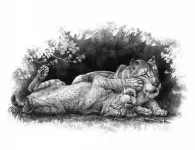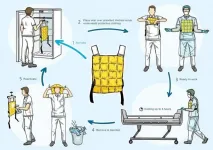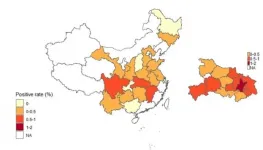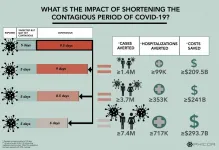(Press-News.org) New research indicates adolescent offspring of the menacing sabre-toothed predator, Smilodon fatalis, were more momma's cubs than independent warriors.
A new study by scientists at the Royal Ontario Museum (ROM) and University of Toronto, published January 7, 2021 in iScience¸ documents a family group of the sabre-toothed cats whose remains were discovered in present-day Ecuador. By studying the fossils, collected for the ROM in the early 1960s, the scientists were able to show that while the supersized Ice Age cats grew quite quickly, they also appeared to stay with their mother for longer than some other large cats before forging their own path.
"This study started out as a simple description of previously unpublished fossils," says Ashley Reynolds, a graduate student based at the Royal Ontario Museum who led the study while completing her PhD research in Ecology & Evolutionary Biology at the University of Toronto. "But when we noticed the two lower jaws we were working on shared a type of tooth only found in about five percent of the Smilodon fatalis population, we knew the work was about to become much more interesting."
Encouraged by this new discovery, the researchers dug deeper and found that they were likely looking at three related individuals: one adult and two "teenaged" cats. What's more, they were able to determine that the younger cats were at least two years old at the time of their death, an age at which some living big cats, such as tigers, are already independent.
To support this conclusion, the team studied the preservation and formation of the Ecuadorian site (an area of study called taphonomy), based on historic collecting records and the suite of clues on the fossil bones themselves.
Historically, Smilodon specimens that have largely been collected from "predator trap" deposits, such as the famous La Brea Tar Pits in Los Angeles, California. But the Ecuador deposit, which formed on an ancient coastal plain, is likely derived from a catastrophic mass death event. This means that, unlike the "traps," all the fossils in the deposit died at the same time. As this preserves a snapshot of an ecosystem, fossils like these can provide new and unique insights into the behaviour of extinct species.
"The social lives of these iconic predators have been mysterious, in part because their concentration in tar seeps leaves so much room for interpretation" says Dr. Kevin Seymour, Assistant Curator of Vertebrate Paleontology at the ROM and a co-author of this study, "This historic assemblage of sabre-cat fossils from Ecuador was formed in a different way, allowing us to determine the two juveniles likely lived, and died, together--and were therefore probably siblings"
The fossils were collected from Coralito, Ecuador in 1961 by A. Gordon Edmund, who was curator of Vertebrate Palaeontology at the ROM from 1954-1990, and Roy R. Lemon, who was curator of Invertebrate Palaeontology from 1957-1969. Together, Edmund and Lemon collected tonnes of tar-soaked sediment which was later prepared at the ROM.
"These world-famous collections made 60 years ago have been studied for years, but a measure of their importance is that they continue to produce new insights into the lives of these extinct animals" says Dr. David Evans, Temerty Chair of Vertebrate Palaeontology at the Royal Ontario Museum and Reynolds's thesis supervisor.
INFORMATION:
Article Reference: Reynolds, A.R., Seymour, K.L., and Evans, D.C. 2021. Smilodon fatalis siblings reveal life history in a saber-toothed cat. iScience.
Patients and healthcare providers at the Princess Margaret Cancer Centre rated virtual care during COVID-19 as highly satisfactory overall for quality of care and convenience, while at the same time saving patients millions in costs.
Research led by Princess Margaret Radiation Oncologist Dr. Alejandro Berlin showed that virtual care can be implemented rapidly and safely across a highly-specialized and high-volume cancer centre. Eighty (80) per cent of patients reported they were either very satisfied or satisfied with it, citing convenience as a main ...
Wearing cooling vests during a COVID-19 shift ensures that nurses experience less heat during their work. During their shifts, nurses wear protective clothing for three hours in a row, during which the temperature can rise to as much as 36 degrees. The cooling vests offer such effective cooling that they are now part of the standard work clothing for nurses in the COVID nursing departments at Radboud university medical center.
Due to the high level of contagiousness present with COVID-19, health care personnel have to work in protective clothing that is not ...
The "Executive Order on Promoting American Seafood Competitiveness and Economic Growth," issued by the Trump administration in May 2020, lays out a plan to expand the U.S. seafood industry, especially aquaculture, and enhance American seafood competitiveness in the global market.
The goals of the directive are focused largely on growth and expansion of the industry, which includes wild-caught fisheries and farm-raised products, as well as recreation, processing and other industries that rely on fishing.
"The seafood industry in general is worth about $200 billion and accounts for 2 million jobs in the United States," ...
Wuhan City in China was the first place to report COVID-19 in the world and--between December 2019 and May 2020--caused nearly two-thirds of all COVID-19 cases in China. Now, researchers reporting in PLOS Neglected Tropical Diseases have tested more than 60,000 healthy individuals in China for SARS-CoV-2 antibodies and concluded that thousands of Wuhan residents were infected with asymptomatic cases of COVID-19 after the infection was believed to be under control in China.
Rapid antibody tests are used to diagnosis present and past infections with the SARS-CoV-2 virus that causes COVID-19; positive IgG antibodies suggests a previous infection while IgM antibodies mean a current or recent ...
A new computational analysis suggests that a vaccine or medication that could shorten the infectious period of COVID-19 may potentially prevent millions of cases and save billions of dollars. The study was led by Bruce Lee along with colleagues in the Public Health Informatics, Computational, and Operations Research (PHICOR) team headquartered at the CUNY Graduate School of Public Health and Health Policy and the Lundquist Research Institute at Harbor-UCLA Medical Center, and publishes in the open-access journal PLOS Computational Biology.
While much of the ...
The fatal threat from diarrhoea and pneumonia to young children in the world's poorer countries can be drastically reduced by using traditional performing arts to encourage mothers to provide youngsters with safe food and water, a new study reveals.
The Gambia, like many other Low- and Middle-income Countries (LMICs) faces high rates of under-five deaths due to diarrhoea and pneumonia - the two highest causes of death in this age group in this country and globally.
Children transitioning from breastfeeding to eating food are at most risk, as complementary food becomes contaminated. Researchers working in The Gambia discovered that mothers' food safety and hygiene behaviours were massively improved by a low-cost behaviour change community ...
ANN ARBOR--A team of researchers has discovered an antibody that blocks the ability of the dengue virus to cause disease in mice. The findings open the potential for developing effective treatments and designing a vaccine for dengue and similar diseases.
Dengue virus, a member of a group of viruses called flaviviruses, causes 50 to 100 million cases of dengue disease each year, with no effective treatment or vaccine. Other members of this group include the viruses that cause Zika, yellow fever and West Nile fever.
In a new study scheduled to publish Jan. 8 in the journal Science, researchers from the University of California, Berkeley, and the University of Michigan revealed how an antibody called 2B7 neutralizes one specific protein made ...
Christina Krienke and colleagues have designed an mRNA vaccine that delayed the onset of and reduced the severity of multiple sclerosis-like disease in mice. The vaccine restores the body's tolerance to its own proteins, suppressing the characteristic immune overreactivity of the disease. The vaccine developed by Krienke et al. works in a targeted fashion to promote tolerance to specific disease-related proteins, an improvement over other approaches to treating the disease that induce systemic immune suppression that can leave an individual vulnerable to other ...
Policymakers around the world tend to reference new and highly cited COVID-19 research papers in their policy documents regarding the pandemic, Yian Yin and colleagues conclude after analyzing publications of both types from the first half of 2020. "Overall, this result shows that the coronavirus research used by policymakers aligns with what scientists heavily engage themselves," they write in a Policy Forum. Although government agencies produced more COVID-19 documents compared to think tanks and intergovernmental organizations such as the World Health Organization, Yin et al. found that governmental agencies are the least likely to cite science. Organizations like WHO are the most likely institutions to cite science, they write, suggesting that these organizations can act ...
Social contact can transfer the feeling of pain or fear in several animal species, including humans, but the exact neural mechanisms for this transmission are still being studied. Now, Monique Smith and colleagues demonstrate that the social transmission of pain and pain relief in mice is mediated by neural projections from the brain's anterior cingulate cortex (ACC) to the nucleus accumbens. The transfer of fear, however, is mediated by the ACC's projections into a different area of the brain called the basolateral amygdala. The findings help untangle the distinct neural circuits involved ...



